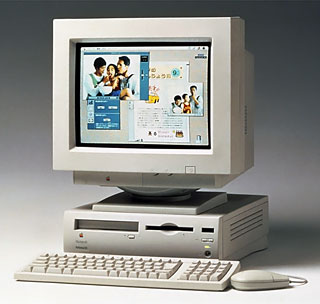1998.10: Face it: The iMac was announced five months ago and is rapidly becoming dated.
Look at the Wintel world. It’s getting hard to find a 233 MHz Windows computer these days, although they were hot when Steve Jobs first announced the iMac in May.
Look at the Mac lineup. Apple has discontinued the 233 MHz Power Mac G3 and gone to 366 MHz on the top end. The entry level PowerBook G3 runs at 233 MHz, but buyers are clamoring for the 266 MHz and 300 MHz models.
The iMac as we know it will survive the Christmas season on momentum, especially if Apple can trim $200 or so off the retail price. But come January, 233 MHz is going to seem so, well, 1998. Apple needs to up the ante.
First of a Family
It’s self-evident that there won’t be just one iMac. Apple has created a new brand identity that should become the trunk of a family tree of iMac computers: economy iMacs, faster iMacs, bigger iMacs.
Who knows just what Apple has up its sleeve? (And Steve Jobs isn’t telling – yet.)

But Apple reaches a milestone on 24 January 1999. That will be exactly 15 years since The Macintosh was first unveiled. I can’t imagine Apple not taking advantage of that to announce several new models: the long-rumored consumer portable, faster PowerBooks, the first G4 Power Macs, and new iMacs.
Update: In January 1999, Apple introduced the Blue & White Power Mac G3 at 300-450 MHz and a 266 MHz iMac in five fruity colors.
The iMac 300
This is conjecture, but I think Apple will continue selling to original iMac as long as there’s a market for it, which could take it until next summer. With a few price cuts along the way, it could be well under $900 by then and give cheap Windows boxes decent competition.
But a lot of people buy specifications, not just looks. For them, a 233 MHz computer will seem dated. (It will be dated.) Apple can create a new iMac at minimal cost from the current model. Differences would include:
- 300 MHz G3 processor with 1 MB backside cache
- 64 MB standard RAM, leaving the top DIMM slot free for memory upgrades
- 32x CD-ROM
- 6-8 MB hard drive
- 6 MB VRAM standard
- 2D/3D graphics acceleration
Apple could do this without making a single change to the case or motherboard. Graphic acceleration could be added using the Perch (or mezzanine) slot. Everything else works in the current design.
Beyond the iMac 300
There will be other models. Maybe an iMac 300 DVD, just like the regular model, but with a DVD player and decoder (which would replace the graphics accelerator in the Perch slot). That would command a premium of several hundred dollars, but by next summer DVD-ROM drive prices should be dropping quickly.
I can’t imagine that we won’t see a “pro” version of the iMac, which could be an iMac 300 with a 17″ screen instead of the current 15″ one. This larger iMac would probably come with DVD as a standard feature.

Performa 630
I’m still enamored of the Tiny iMac, a monitor-free model about the size of the Macintosh LC, IIsi, or Performa 630. This would be the only iMac designed as an upgrade model for owners of older Macs – a market I hope Apple will tap into.
And I think iMacTV would sell like hotcakes. Combining the Tiny iMac with DVD, an infrared keyboard with trackpad, and video output for both a computer monitor and your TV, it could be a hot home theater item. Look at it as WebTV meets PlayStation meets the DVD player meets the iMac.
Update: This article was published one week before Apple announced the Rev. B iMac, which looked just like the original iMac but had a better graphics chip, more video memory, and could use its power button as a reset button when the iMac crashed. I was anticipating a bit more of an upgrade. That came in January 1999, and DVD-ROM finally came to the iMac in October 1999.
Related Reading
- iMacTV, Take 2, 24 September
- I Want iMacTV, 17 September
- A Compact iMac?, 10 September
- The Tiny iMac, 5 August 1998
- The iMac: First of a Family?, 5 July 1998
keywords: #imac

